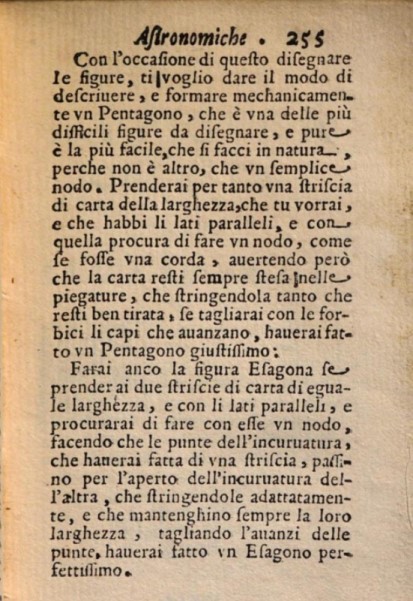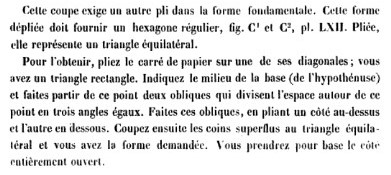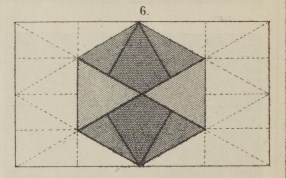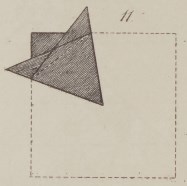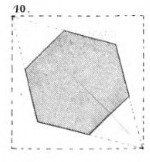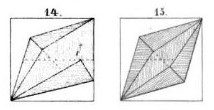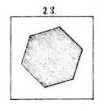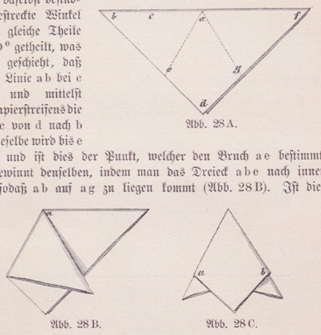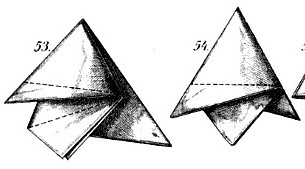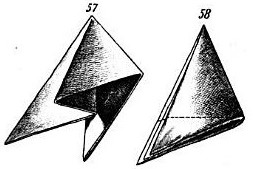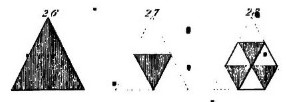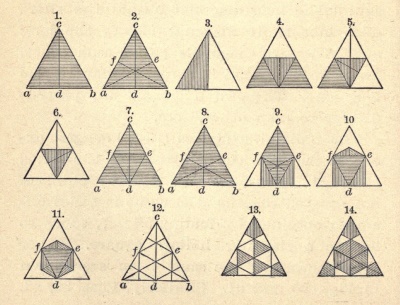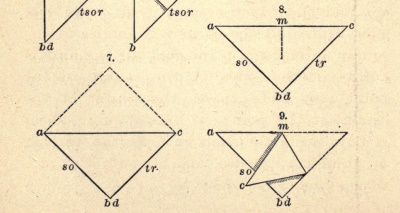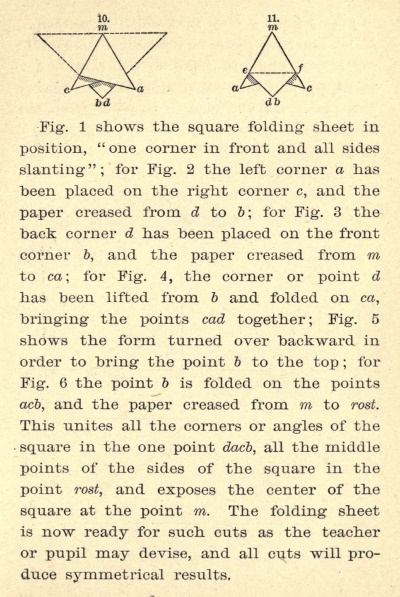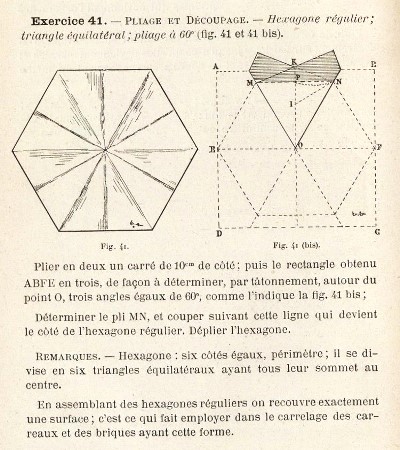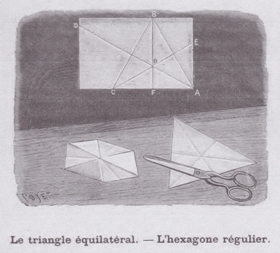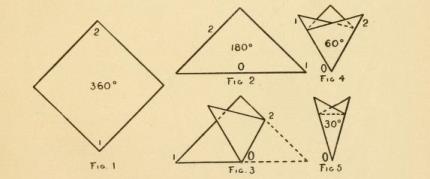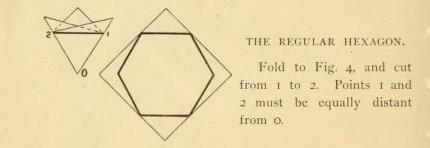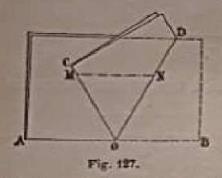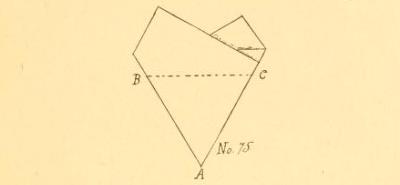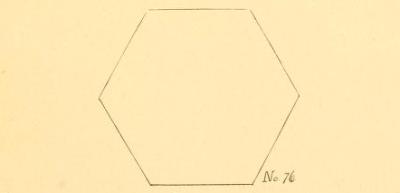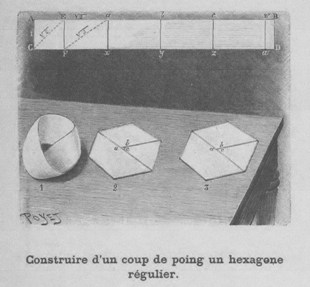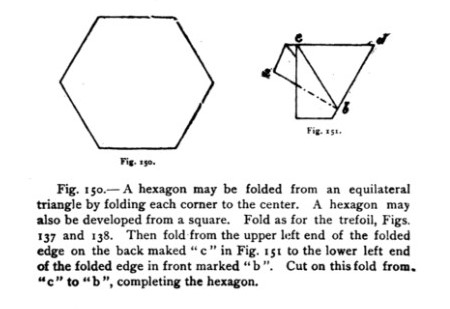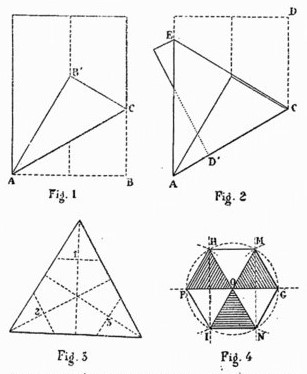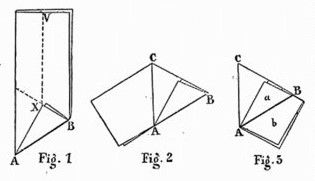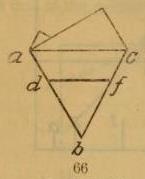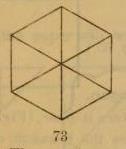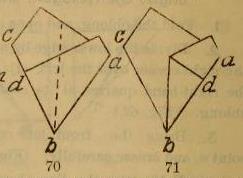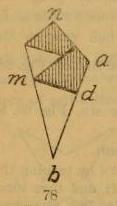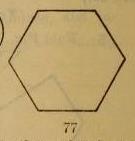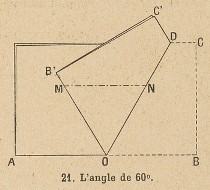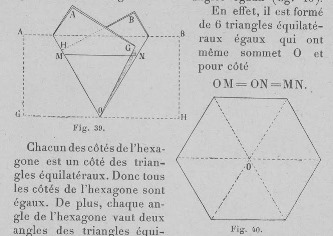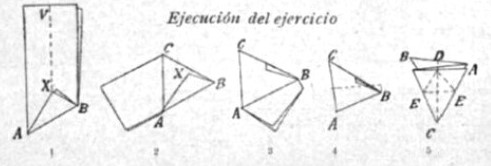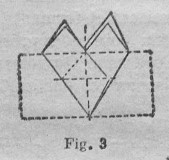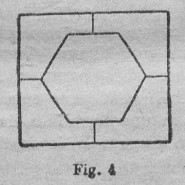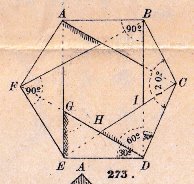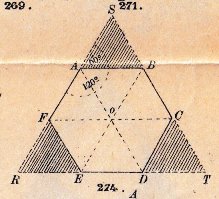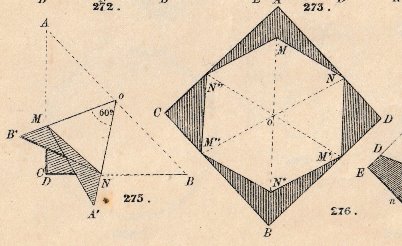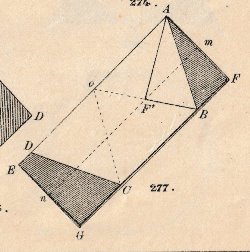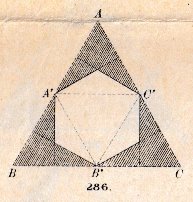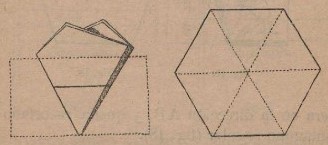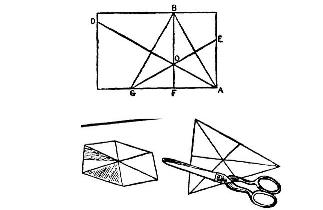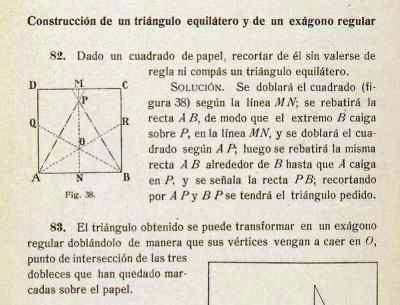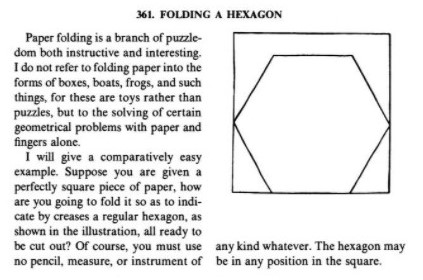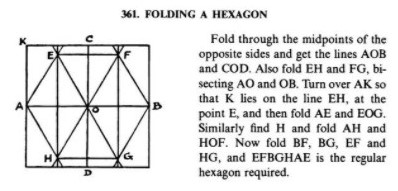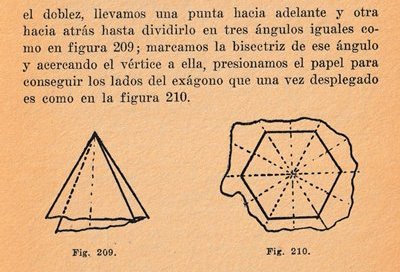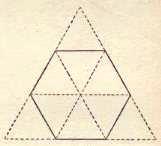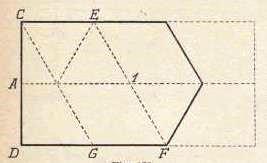| The Public Paperfolding History Project
Last updated 22/9/2025 x |
|||||||
| How to Construct the Regular Hexagon by Folding Paper | |||||||
| This
page is being used to collect information about the
history of ways of constructing the regular hexagon by
folding paper. Please contact me if you know any of this
information is incorrect or if you have any other
information that should be added. Thank you. This page includes information about constructing a regular hexagon by the fold and one cut method. ********** 1682 - Constructing a regular hexagon from two strips knotted together A description of how to fold a hexagonal knot appears in the 1682 second edition of 'Trattato Della Sfera' in a section called 'Prattische Astronomonische. Intorno all circoli della Sfera' which was an addition to the original work by Urban d'Aviso and did not appear in the 1656 first edition. (The first paragraph explains how to fold a pentagonal knot.)
The second paragraph can be translated, roughly, as 'You can also make a figure in the shape of a hexagon if you take two strips of paper of equal length, and with the sides parallel, and make a knot with them, making the tips of the curvature of one strip, pass through the opening of the curvature of the other, so that by tightening them properly, always keeping their width and cutting the leftovers of the tips, you will have made a true Hexagon.' ********** 1859 'Manuel pratique des jardins d'enfants de Frédéric Froebel', which was compiled by J F Jacobs and published by F Claassen in Brussells and L Hachette and Cie in Paris in 1859, contains a description of a method of creating a Fold and One Cut Hexagon from a square:
In English, roughly, 'fold the square of paper on one of its diagonals; you have a rectangle triangle. Find the midpoint of the base ... and from this point start two obliques which divide the space around this point into three equal angles ... then cut off the superfluous corners.' ********** 1863 An illustration which depicts the construction of a hexagon from a bronze rectangle appears in 'De Kleine Papierwerkers 1: Wat men van een stukje papier al maken kan: Het vouwen' (The Small Paperwork 1: What one can make from a piece of paper: Folding) by Elise Van Calcar, which was published by K H Schadd in Amsterdam in 1863.
********** 'De Kleine Papierwerkers: Volume 4: Het Knippen en plakken' (Cutting and Pasting), written by Elise Van Calcar and published by K H Schadd in Amsterdam in 1863, shows how to create a hexagon from a square using the same method as in Jacobs above.
********** 1872 The second 'expanded and improved' edition of 'Das Frobel'sche Faltblatt' (Frobel's Folding Sheet) ) by August Kohler, which was published by Hermann Bohlau in Weimar in 1872, contains a method of constructing a regular hexagon.
********** Various similar / other methods of constructing the regular hexagon by folding appear in: 1873 'Die Praxis Des Kindergartens' by Auguste Koehler, which was published by Herman Bohlau in Weimar in 1873 contains a method of producing a regular hexagon by truncating a diamond folded from a square.
********** 1876 'Des Kindes Erste Beschaftigungsbuch' by E Barth and W Niederley, which was first published in Bielefeld and Leipzig, and the foreword of which is dated October 1876.
********** Part 2 of 'Die Praxis' of 'Theoretisches und praktisches Handbuch der Fröbelschen Erziehungslehre' by Bertha von Marentholtz-Bülow, which was published by George H Wigand in Kassel in 1887.
********** 1877 'Kindergarten Practice' by Mary Gurney, a substantially abridged version, in two parts, of 'Die Praxis Des Kindergartens' by Auguste Koehler. The second part, 'Froebel's Plane Surfaces', contains sections dealing with paper folding, cutting and weaving. The date of the first edition is not known. The second edition was published in 1877 in London by A N Myers and Co.
********** 1887 Two methods olf constructing a hexagon by folding and/or folding and cutting paper appeared in 'Primary Methods: A Complete and Methodical Presentation of the Use of Kindergarten Material in the Primary School' by W N Hailmann, which was published by A S Barnes and Company in New York and Chicago in 1887.
***
********** 1887 As 'Rosace' in 'Le Travail Manuel a L'ecole Primaire' by M. Coste et J. Lapassade, which was published by Lafon, Vve Ribaut et Tonnet in Pau and A Jeande in Paris in 1887.
********** Various similar / other methods of constructing the regular hexagon by folding appear: 1891 In Volume 2 of 'La Science Amusante' by Tom Tit (real name Arthur Good), which was published in Paris by Librairie Larousse in 1891.
********** 1891 There is reference to constructing a hexagon from a square in the 'Bulletin de la Societe de Protection des Apprentis', an official document issued by the Societe de Protection des Apprentis et des Enfants Employes par les Manufactures in Paris in 1891. ********** 1892 In 'Paper Folding and Cutting' by Katherine M Ball, which was published by the Prang Educational Company in Boston in 1892.
********** 1892 In 'Le Travail Manuel a L'ecole Primaire' by Jully & Rocheron, which was published by Librairie Classique Eugene Belin in Paris in 1892.
********** In 'How to Teach Paper-Folding and Cutting' by Norma MacLeod, which was published by March Brothers in Lebanon, Ohio in 1892.
********** From a Mobius Band by Un Coup de Poing - 1893 onwards
********** Methods also appeared: 1893 In 'Paper and Scissors in the Schoolroom' by Emily Weaver, which was published by Milton Bradley Company in Springfield, Massachusetts in 1893
********** 1894 In an article by J Marteau in Manuel General de L'Instruction Primaire, 4th August 1894.
********** A method of constructing a hexagon from an oblong appears in an article by J Marteau in Manuel General de L'Instruction Primaire, October 1894.
********** In 'Old Glory: The Flag of Our Country: A Study in History and a Lesson in Paperfolding: Also Some Easy Lessons in Cutting and Folding' by Dr Albert Elias Maltby, which was published in Slippery Rock, Pennsylvania in 1894. Method 1
********** Variation - Method 2 I am not sure wehat the advantage of this method is over the first.
********** 1895 In 'L'enseignement manuel dans les ecoles du degre primaire (garcons)' by Rene Leblanc, which was published by Librairie Larousse in Paris in 1895.
********** In 'Geometrie, Dessin et Travaux Manuels - Cours Moyen', produced under the direction of M E. Cazes, which was published by Librairie Ch. Delagrave in Paris in 1895.
********** 1896 'Pleasant Work for Busy Fingers' by Maggie Browne, which is an English version of 'Des Kindes Erste Beschaftigungsbuch', and was published by Cassell and Company in London in 1896. It contains the method of creating a fold and one cut hexagon pictured under the entry for 1876 above. ********** 1900 A way of making a hexagon from an oblong appears in an article in El Monitor 331 of 30th September 1900 (which is a translation of several chapters of Savineau).
********** 1909 In 'Petit Manuel de Travaux d'Amateurs' by H de Graffigny was published by Collection A L Guyot in Paris in 1909, under the title 'Former un hexagone avec un carre'.
********** 1913 'Trabajo Manual' by C Champy Alvear, which was published by Cabaut y Cia in Buenos Aires in 1913, provides five ways of obtaining a regular hexagon by folding paper: A hexagon woven from a strip
*** Constructing a hexagon from an equilateral triangle
*** The Fold and One Cut Hexagon (from a square)
*** Constructing a hexagon from a rectangle
********** Another way of obtaining a hexagon from an equilateral triangle
********** 1914 'El Trabajo Manual en la Escuela' by Félix Martí Alpera, which was published by Libreria de los Sucesores de Hernando in Madrid in 1914.
********** 1918 'Scientific Amusements' (an English translation of some of the material from volumes 2 and 3 of 'La Science Amusante' by Tom Tit) which was published by Thomas Nelson and Sons Ltd in London in 1918.
********** 'Ciencia Recreativa' by Jose Estralella, which was published by Gustavo Gili in Barcelona in 1918.
********** 1926 As a puzzle in 'Modern Puzzles' by Henry Ernest Dudeney, which was published by C. Arthur Pearson in London in 1926.
Solution
********** 1939 A way of obtaining a regular hexagon from irregularly-shaped paper appears in 'Trabajo Manual Educativo' by Araminta V Aramburu, which was published by F Crespillo in Buenos Aires in 1939.
********* 1940 'El Plegado y Cartonaje en la Escuela Primaria' by Antonio M Luchia and Corina Luciani de Luchia, which was published by Editorial Kapelusz in Buenos Aires in 1940, and which contains explanations of two different methods:
***
********** 1951 A method of constructing a regtular hexagon from a rectangle appears in Plegado laminas published by Della Penna, April 1951. Construccion de un exagono regular
********** |
|||||||
